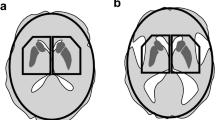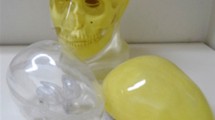Abstract
Objective
In Japan, the Southampton method for dopamine transporter (DAT) SPECT is widely used to quantitatively evaluate striatal radioactivity. The specific binding ratio (SBR) is the ratio of specific to non-specific binding observed after placing pentagonal striatal voxels of interest (VOIs) as references. Although the method can reduce the partial volume effect, the SBR may fluctuate due to the presence of low-count areas of cerebrospinal fluid (CSF), caused by brain atrophy, in the striatal VOIs. We examined the effect of the exclusion of low-count VOIs on SBR measurement.
Methods
We retrospectively reviewed DAT imaging of 36 patients with parkinsonian syndromes performed after injection of 123I-FP-CIT. SPECT data were reconstructed using three conditions. We defined the CSF area in each SPECT image after segmenting the brain tissues. A merged image of gray and white matter images was constructed from each patient’s magnetic resonance imaging (MRI) to create an idealized brain image that excluded the CSF fraction (MRI-mask method). We calculated the SBR and asymmetric index (AI) in the MRI-mask method for each reconstruction condition. We then calculated the mean and standard deviation (SD) of voxel RI counts in the reference VOI without the striatal VOIs in each image, and determined the SBR by excluding the low-count pixels (threshold method) using five thresholds: mean-0.0SD, mean-0.5SD, mean-1.0SD, mean-1.5SD, and mean-2.0SD. We also calculated the AIs from the SBRs measured using the threshold method. We examined the correlation among the SBRs of the threshold method, between the uncorrected SBRs and the SBRs of the MRI-mask method, and between the uncorrected AIs and the AIs of the MRI-mask method.
Results
The intraclass correlation coefficient indicated an extremely high correlation among the SBRs and among the AIs of the MRI-mask and threshold methods at thresholds between mean-2.0D and mean-1.0SD, regardless of the reconstruction correction. The differences among the SBRs and the AIs of the two methods were smallest at thresholds between man-2.0SD and mean-1.0SD.
Conclusion
The SBR calculated using the threshold method was highly correlated with the MRI–SBR. These results suggest that the CSF correction of the threshold method is effective for the calculation of idealized SBR and AI values.







Similar content being viewed by others
References
Cummings JL, Henchcliffe C, Schaier S, Simuni T, Waxman A, Kemp P. The role of dopaminergic imaging in patients with symptoms of dopaminergic system neurodegeneration. Brain. 2011;134(Pt 11):3146–66.
Tatsch K, Poepperl G. Nigrostriatal dopamine terminal imaging with dopamine transporter SPECT: an update. J Nucl Med. 2013;54(8):1331–8.
Habraken JB, Booij J, Slomka P, Sokole EB, van Royen EA. Quantification and visualization of defects of the functional dopaminergic system using an automatic algorithm. J Nucl Med. 1999;40(7):1091–7.
Takikawa S, Dhawan V, Chaly T, Robeson W, Dahl R, Zanzi I, et al. Input functions for 6-[fluorine-18] fluorodopa quantitation in parkinsonism: comparative studies and clinical correlations. J Nucl Med. 1994;35:955–63.
Dhawan V, Ma Y, Pillai V, Spetsieris P, Chaly T, Belakhlef A, et al. Comparative analysis of striatal FDOPA uptake in Parkinson’s disease: ratio method versus graphical approach. J Nucl Med. 2002;43:1324–30.
Jokinen P, Helenius H, Rauhala E, Bru¨ck A, Eskola O, Rinne JO. Simple ratio analysis of 18F-fluorodopa uptake in striatal subregions separates patients with early Parkinson disease from healthy controls. J Nucl Med. 2009;50:893–9.
Joutsa J, Johansson J, Kaasinen V. Is occipital cortex a valid reference region in 123I-FP-CIT SPECT imaging? Clin Nucl Med. 2015;40:615–6.
Tossici-Bolt L, Hoffmann SM, Kemp PM, Mehta RL, Fleming JS. Quantification of [123I]FP-CIT SPECT brain images: an accurate technique for measurement of the specific binding ratio. Eur J Nucl Med Mol Imaging. 2006;33(12):1491–9.
Tossici-Bolt L, Dickson JC, Sera T, de Nijs R, Bagnara MC, Jonsson C, Scheepers E, Zito F, Seese A, Koulibaly PM, Kapucu OL, Koole M, Raith M, George J, Lonsdale MN, Münzing W, Tatsch K, Varrone A. Calibration of gamma camera systems for a multicentre European ¹²³I-FP-CIT SPECT normal database. Eur J Nucl Med Mol Imaging. 2011;38(8):1529–40.
Buchert R, Kluge A, Tossici-Bolt L, Dickson J, Bronzel M, Lange C, Asenbaum S, Booij J, Atay Kapucu L, Svarer C, Koulibaly Pobili F, Pagani M, Sabri O, Sera T, Tatsch K, Vander Borght T, Van Laere K, Varrone A, Iida H. Reduction in camera-specific variability in [123I] FP-CIT SPECT outcome measures by image reconstruction optimized for multisite settings: impact on age-dependence of the specific binding ratio in the ENC-DAT database of healthy controls. Eur J Nucl Med Mol Imaging. 2016;43(7):1323–36.
Ichihara T, Ogawa K, Motomura N, Kubo A, Hashimoto S. Compton scatter compensation using the triple-energy window method for single- and dual-isotope SPECT. J Nucl Med. 1993;34(12):2216–21.
Penny WD, Friston KJ, Ashburner JT, Kiebel SJ, Nichols TE. Statistical mapping: the analysis of functional brain imaging, 1st edn. 2006; Academic Press.
Ashburner J. A fast diffeomorphic image registration algorithm. NeuroImage. 2007;38(1):95–113.
Ashburner J, Friston K. Computing average shaped tissue probability templates. NeuroImage. 2009;45(2):333–41.
Minoshima S, Berger KL, Lee KS, Mintun MA. An automated method for rotational correction and centering of three-dimensional functional brain images. J Nucl Med. 1992;33:1579 – 1585.
Minoshima S, Koeppe RA, Mintun MA, et al. Automated detection of the intercommissural line for stereotactic localization of functional brain images. J Nucl Med. 1993;34:322–9.
Minoshima S, Koeppe RA, Frey KA, Kuhl DE. Anatomical standardization: linear scaling and nonlinear warping of functional brain images. J Nucl Med. 1994;35:1528 – 1537.
Author information
Authors and Affiliations
Corresponding author
Ethics declarations
Conflict of interest
KN and AM are employees of Nihon Medi-Physics Co., Ltd. All other authors declare that they have no conflicts of interest.
Rights and permissions
About this article
Cite this article
Mizumura, S., Nishikawa, K., Murata, A. et al. Improvement in the measurement error of the specific binding ratio in dopamine transporter SPECT imaging due to exclusion of the cerebrospinal fluid fraction using the threshold of voxel RI count. Ann Nucl Med 32, 288–296 (2018). https://doi.org/10.1007/s12149-018-1249-9
Received:
Accepted:
Published:
Issue Date:
DOI: https://doi.org/10.1007/s12149-018-1249-9




